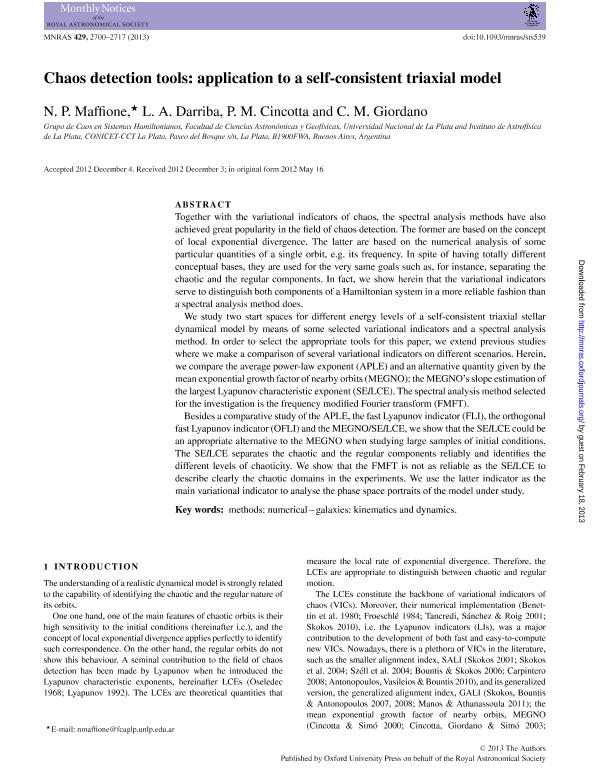Artículo
Chaos indicators and a spectral analysis: application to a self-consistent triaxial model
Maffione, Nicolas Pablo ; Darriba, Luciano Ariel
; Darriba, Luciano Ariel ; Cincotta, Pablo Miguel
; Cincotta, Pablo Miguel ; Giordano, Claudia Marcela
; Giordano, Claudia Marcela
 ; Darriba, Luciano Ariel
; Darriba, Luciano Ariel ; Cincotta, Pablo Miguel
; Cincotta, Pablo Miguel ; Giordano, Claudia Marcela
; Giordano, Claudia Marcela
Fecha de publicación:
03/2013
Editorial:
Oxford University Press
Revista:
Monthly Notices Of The Royal Astronomical Society
ISSN:
0035-8711
Idioma:
Inglés
Tipo de recurso:
Artículo publicado
Clasificación temática:
Resumen
Together with the variational indicators of chaos, the spectral analysis methods have also achieved great popularity in the field of chaos detection. The former are based on the concept of local exponential divergence. The latter are based on the numerical analysis of some particular quantities of a single orbit, e.g. its frequency. In spite of having totally different conceptual bases, they are used for the very same goals such as, for instance, separating the chaotic and the regular components. In fact, we show herein that the variational indicators serve to distinguish both components of a Hamiltonian system in a more reliable fashion than a spectral analysis method does.
We study two start spaces for different energy levels of a self-consistent triaxial stellar dynamical model by means of some selected variational indicators and a spectral analysis method. In order to select the appropriate tools for this paper, we extend previous studies where we make a comparison of several variational indicators on different scenarios. Herein, we compare the average power-law exponent (APLE) and an alternative quantity given by the mean exponential growth factor of nearby orbits (MEGNO): the MEGNO's slope estimation of the largest Lyapunov characteristic exponent (SElLCE). The spectral analysis method selected for the investigation is the frequency modified Fourier transform (FMFT).
Besides a comparative study of the APLE, the fast Lyapunov indicator (FLI), the orthogonal fast Lyapunov indicator (OFLI) and the MEGNO/SElLCE, we show that the SElLCE could be an appropriate alternative to the MEGNO when studying large samples of initial conditions. The SElLCE separates the chaotic and the regular components reliably and identifies the different levels of chaoticity. We show that the FMFT is not as reliable as the SElLCE to describe clearly the chaotic domains in the experiments. We use the latter indicator as the main variational indicator to analyse the phase space portraits of the model under study.
Palabras clave:
Numerical Methods
,
Galaxies
,
Kinematics
,
Dynamics
Archivos asociados
Licencia
Identificadores
Colecciones
Articulos(IALP)
Articulos de INST.DE ASTROFISICA LA PLATA
Articulos de INST.DE ASTROFISICA LA PLATA
Citación
Maffione, Nicolas Pablo; Darriba, Luciano Ariel; Cincotta, Pablo Miguel; Giordano, Claudia Marcela; Chaos indicators and a spectral analysis: application to a self-consistent triaxial model; Oxford University Press; Monthly Notices Of The Royal Astronomical Society; 429; 3; 3-2013; 2700-2717
Compartir
Altmétricas



